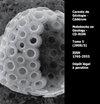Additional contributions to the knowledge of the Taquaral Member, Irati Formation (Lower Permian, Paraná Basin): Taphonomy and paleoenvironmental implications
IF 1.5
4区 地球科学
Q2 GEOLOGY
引用次数: 5
Abstract
The silty shale facies of the Taquaral Member (Irati Formation), which is one of the Permian units in the Brazilian Parana Basin, is discussed here based on the taphonomy relevant to the paleoenvironmental interpretation. The fossils are crustaceans (Clarkecaris and other indeterminate forms), isolated teeth, scales and bones of Actinopterygii, "Palaeonisciformes ", which are the most common vertebrate remains, and also frequent scales of Coelacanthiformes. The scales, teeth and disarticulated bones are found together in accumulations, which may be interpreted as coprolites. Many of the fossil crustaceans display characteristics of ecdysis.对paran盆地下二叠统Irati组Taquaral段知识的额外贡献:地层学和古环境意义
根据与古环境解释有关的地层岩性,讨论了巴西巴拉那盆地二叠纪单元之一的Taquaral段(Irati组)的粉砂质页岩相。这些化石是甲壳类动物(Clarkecaris和其他不确定的形式),放线鸟纲的孤立牙齿、鳞片和骨头,是最常见的脊椎动物遗骸,也是腔棘鱼目的常见鳞片。鳞片、牙齿和关节缺失的骨头聚集在一起,可以被解释为粪化石。许多甲壳类动物化石显示出蜕皮的特征。
本文章由计算机程序翻译,如有差异,请以英文原文为准。
求助全文
约1分钟内获得全文
求助全文
来源期刊

Carnets De Geologie
Earth and Planetary Sciences-Geology
CiteScore
2.90
自引率
14.30%
发文量
21
审稿时长
>12 weeks
期刊介绍:
Information not localized
 求助内容:
求助内容: 应助结果提醒方式:
应助结果提醒方式:


